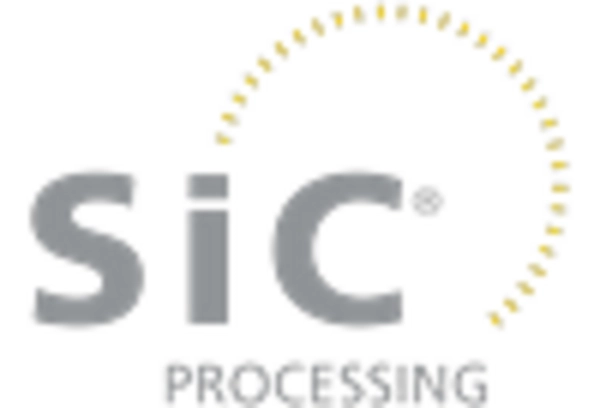Market Analysis
Silicon Carbide Market (Global, 2024)
Introduction
The silicon carbide market is about to be transformed as industries increasingly adopt advanced materials that offer superior performance and efficiency. In particular, silicon carbide, with its outstanding thermal conductivity, high breakdown strength, and chemical inertness, is increasingly being used in a wide range of applications in the power-electronics, automotive, and renewable energy industries. The demand for energy-efficient solutions is growing, and the use of silicon carbide in semiconductor devices is gaining momentum, driven by the need to improve the performance of power systems and to reduce energy losses. Furthermore, the transition to electric vehicles and the increased emphasis on sustainability are driving the development of silicon carbide technology, which is now becoming a critical component in the development of next-generation power devices. This report explores the current state of the silicon carbide market and the main trends that will shape it in the coming years.
PESTLE Analysis
- Political
- In 2024, the politics of the silicon carbide market are heavily influenced by the government’s policies to promote the manufacture of semiconductors. In the United States, the Chips Act of 2021 allocates approximately fifty-two billion dollars to the development of domestic production of semiconductors and related materials. In the European Union, a goal has been set to increase the share of the European Union in global semiconductor production to 20 percent by the year 2030. This goal will also drive the demand for silicon carbide components in a variety of applications.
- Economic
- In 2024 the silicon carbide market was characterized by rising raw material costs, and silicon carbide prices were about $3,500 per metric ton, a 15% increase over the previous year. The increase was due to the disruptions in the supply chain and to the growing demand from the electric vehicle (EV) sector, which was projected to consume over 30% of all silicon carbide produced. The market for semiconductors was also expected to reach $600 billion in 2024, which would enhance the economic viability of silicon carbide applications.
- Social
- In 2024, the social trends influencing the choice of technology for the future are in the direction of sustainable and energy-saving ones. This is why silicon carbide is being used more and more in electric vehicles and in the manufacture of alternative energy. Surveys show that 78% of consumers are willing to pay a higher price for products made from eco-friendly materials, which is a good position for silicon carbide. In addition, the awareness of climate change and the need to reduce CO2 emissions pushes the industry to use silicon carbide-based technology, which is known for its high efficiency and low energy consumption.
- Technological
- In 2024, the capabilities of silicon carbide devices have increased considerably. Using new manufacturing methods, the yield of silicon carbide wafers has risen to about 90 percent, from 75 percent in 2023. In power electronics, the introduction of 1200 Volt MOSFETs enables a higher degree of efficiency and performance in a wide range of applications, from electric vehicles to renewable energy systems. This technological progress is essential for meeting the rising demand for high-performance components in various fields.
- Legal
- In 2024 the legal framework regulating the silicon carbide market is shaped by strict regulations aimed at ensuring product safety and compliance with the environment. REACH, the European Union regulation on registration of chemical substances, also applies to silicon carbide and affects about 30,000 companies in the EU. According to estimates, the costs of testing and documentation in compliance with these regulations are estimated at up to $ 1.8 million per company, which may have a significant impact on the operating costs of silicon carbide producers.
- Environmental
- In the year 2024, the market for silicon carbide is becoming increasingly influenced by considerations of the environment. Production of silicon carbide involves the release of approximately ten kilograms of carbon dioxide per kilogram of silicon carbide produced. However, in the next few years, new methods of production are expected to reduce this figure by a factor of twenty. In addition, there will be an increasing demand for silicon carbide in the context of a circular economy. In 2024, approximately ten per cent of all production will be recycled, contributing to the establishment of a circular economy.
Porter's Five Forces
- Threat of New Entrants
- The silicon carbide market has a moderate barrier to entry, because of the high capital investment required for production and technology. The development of manufacturing processes and the increasing demand for silicon carbide in various applications, however, may attract new players, resulting in a moderate threat level.
- Bargaining Power of Suppliers
- “Silicon carbide is a relatively abundant source of raw materials, which reduces the bargaining power of the suppliers.” “In addition, the number of suppliers is large, and it is easy for manufacturers to change suppliers when necessary.”
- Bargaining Power of Buyers
- In the market for silicon carbide, buyers have significant negotiating power because of the presence of many suppliers and the availability of alternative materials. The more price-conscious the buyer, the more powerful the bargaining power.
- Threat of Substitutes
- “The material silicon carbide is particularly suited for certain applications, but there are alternatives such as gallium nitride and ordinary silicon that can be used as substitutes.” The threat of substitution is moderate, because the performance of these alternatives may not be the same as silicon carbide, but they can still compete in certain markets.
- Competitive Rivalry
- The market for silicon carbide is characterized by intense competition between established players and new entrants. The rising demand for electric vehicles, alternative energy sources and high-tech electronics is resulting in a highly competitive market and continuous innovation in product development.
SWOT Analysis
Strengths
- High thermal conductivity and efficiency in power electronics applications.
- Growing demand in electric vehicle (EV) and renewable energy sectors.
- Established supply chain and manufacturing capabilities in key regions.
Weaknesses
- High production costs compared to traditional silicon materials.
- Limited awareness and understanding of silicon carbide technology among some end-users.
- Challenges in scaling up production to meet increasing demand.
Opportunities
- Expansion of electric vehicle market driving demand for silicon carbide components.
- Potential for new applications in 5G technology and advanced telecommunications.
- Government incentives and policies promoting renewable energy adoption.
Threats
- Intense competition from alternative materials and technologies.
- Economic fluctuations impacting investment in semiconductor technologies.
- Supply chain disruptions due to geopolitical tensions or natural disasters.
Summary
During the period 2021–2024, the silicon carbide market will be characterized by its technological strengths and a rising demand, especially in the electric vehicles and alternative energy sectors. However, the high cost of production and low awareness of the product will remain obstacles to growth. Competition and disruptions to supply chains will pose the greatest risks to the market. The strategic focus on cost reduction and education could improve the market’s positioning.















Leave a Comment